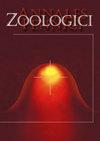饲喂试验饲粮的山羊(Capra aegagrus hircus)内介膜III的试验研究
IF 0.9
4区 生物学
Q4 ECOLOGY
引用次数: 4
摘要
有蹄类动物牙齿上的磨损模式有助于了解个体一生中的饮食习惯。介观磨损是在低倍率下检测牙齿磨损模式的一系列技术。在mesowear I及其简化版mesowear II中,观察食草动物臼齿尖的外部轮廓来分配饮食,而mesowear III(或内mesowear)对牙齿内牙釉质带的磨损面进行评分。与前两种方法相比,这种方法可以在更短的时间内检测到更精细的饮食信号。我们对26只饲喂不同日粮的山羊(Capra aegagrus hircus)颅骨进行了为期6个月的试验,这些山羊的头盖骨中已经有了I和II的评分。我们的目标是探索具有不同研磨性的饮食对饮食信号的影响,比较两种技术记录的信号。我们发现,在不同饮食中,介观磨损III信号没有差异,尽管可见的趋势是更磨蚀的饮食导致更高的介观磨损评分。我们也发现介面III和I在时间分辨率上没有差异。本文章由计算机程序翻译,如有差异,请以英文原文为准。
Testing Inner-Mesowear III on Goats (Capra aegagrus hircus) Fed Experimental Diets
The wear patterns on ungulate's teeth help to understand dietary habits during an individual's lifetime. Mesowear is a series of techniques used to detect tooth wear patterns at low magnification. While in mesowear I, and its simplified version mesowear II, the outer profile of a herbivore's molar cusps is observed to assign a diet, mesowear III (or inner-mesowear) scores the wear facets on the inner enamel band of the tooth. This approach was developed to detect finer dietary signals for shorter periods than the two former mesowear methods. We tested this method on skulls of 26 goats (Capra aegagrus hircus) fed different diets for six months, for which mesowear I and II had already been scored. Our goal was to explore the effects of diets with varying abrasiveness on the dietary signal, comparing signals recorded with both techniques. We found no differences in mesowear III signals among diets, regardless of visible tendency of more abrasive diets leading to higher mesowear scores. We also found no difference in time resolution between mesowear III and I.
求助全文
通过发布文献求助,成功后即可免费获取论文全文。
去求助
来源期刊

Annales Zoologici Fennici
生物-动物学
CiteScore
2.40
自引率
14.30%
发文量
10
审稿时长
>12 weeks
期刊介绍:
Annales Zoologici Fennici publishes mainly original research reports, but also in-depth reviews and commentaries on all aspects of animal ecology and evolution, and fields related to them. Our aim is to promote papers which focus on the interactions among various components in the past and present environments by using integrative and cross-disciplinary approaches. This may be achieved by employing tools from different fields of research, such as (but not restricted to):
ecology and paleoecology,
molecular ecology and phylogeography,
conservation biology, human-induced contemporary evolution and wildlife management,
animal behaviour and interactions (including recognition systems and mechanisms),
paleontology (except systematics and taxonomy) and evolution,
bioenergetics.
 求助内容:
求助内容: 应助结果提醒方式:
应助结果提醒方式:


